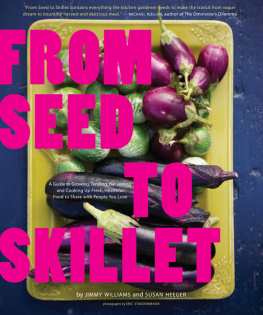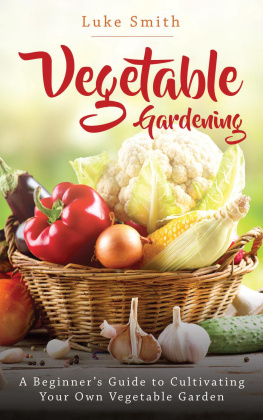

ACKNOWLEDGMENTS
We would like to thank the following people, whose generous help, input, and, in many cases, shared gardens made this book possible.
Judith Belzer; Jonathan Berg; Mort Bernstein; Michelle Clair; Robin and Manny Coto; Nancy Deane; Chloe Rose Elia; Annette Elmo; Sasha Emerson; Jacob Epstein; Elena Esparza; Claire Fletcher; Sarajo Frieden; Kristina Fukuda-Schmid; Dede Gardner-Berg; Laurel Garza; Steve Goto; Grandmother Nana; John, Laura, Marcia, and Michael Heeger; John and Diane Hertz; Gail Hochman; Tim and Julia Johnson; Kiki Kapany; Safa Kasem-Hayes; Jennifer Kell; Kiran; Jeannie Kusserow; Lily Pearl Langos; Jason La Padura; Josh Loeb; Christina Loff; Thomas McCarry; Susan McKean; Bill McKibben; Echo, Fin, and Tato Miyamoto; Patricia Moritz; Gary Murphy; Zoe Nathan; Susie Norris; Michael Pollan; Michelle Reiner; Nicole Rouzan; Martha Ryan; Jessica Sanchez; Yvonne Savio; Andrew Schapiro; Michael Schwarz; Bill Shank; Laurie Sorenson; Naomi Starkman; Hannah, Otto, and Saida Staudenmaier; Simon Steiner; Alexandra, Dominic, Luc, and Zita Surprenant; Amy Treadwell; Jodi Warshaw; Monica Weil; Brody, Derrick, Elaine, Fred, Gary, Gertrude, Larry, Lawrence, Logan, Patrice, Porter, Rosanne, Terry, Thelma, and Wayne Williams; and Richie Wingfield.

Bill McKibben,
Author Earth: Making a Life on a Tough New Planet
There are a number of stories that people endlessly repeat about local food, and indeed, about anything environmentally sane: that its for rich people, that its for white people, that its just some trendy lifestyle. This beautiful book sets the lie to those notions. The authors great-great-great-grandmother brought tomato seeds in her apron pocket on a slave shiphe grew up eating the descendants of those Goosecreek tomatoes with his eleven siblings in their Long Island, New York, home, and it was the first variety he grew to sell in the farmers markets of Los Angeles. Its the kind of story that reminds us that most people on this planet are unconsciously environmentaland that those good habits lie buried, dormant in us, like seeds waiting for the spring rain.
But of course good intentions are not enough, so the next best thing about this volume is the fact that it simply and straightforwardly demystifies vegetable gardening. You dont need immense amounts of equipment, or space, or expertise to get startedbut it will help enormously to have these simple suggestions, diagrams, and photos to inspire and illuminate.
Dont read it if you want an excuse not to gardenby the time youre done, you wont have any.
Finally, it reminds us that food really is the place to startnot just to make environmental sense but to build community, which is, in the end, even more important. One of my favorite statistics: The average shopper at a farmers market has ten times more conversations per visit than the average shopper at a supermarket. Theyre having the kind of conversations youll find in these pageslively, joyful, informed. This is a passport to a different worldone that much of the planet inhabits, and that you can too.
I was raised in a family of twelve children in African-American neighborhoods around Eastern Long Island, and for us, growing food was a necessity. We had to work in the garden if we wanted to eat. But for me, gardening quickly moved beyond work to something much more intriguing and absorbing. Watching my grandmother Eloisemy first gardening teachertend her plants made them interesting. It opened up a world to mea small universe of complex, interconnected lives that I could be a part of.
MIRACLES IN DRESSER DRAWERS
My grandmothera South Carolina native who grew up in a traditional Gullah community whose members were descendants of Caribbean slaveslearned to garden from her grandmother. She had a confident touch with plants, very focused and deliberate. She wasted nothingfood, words, even her own energy. Funny, wise, and patient, she taught us by example to value what we could make with our hands. For her, cast-off dresser drawers, divided into compartments, made perfect trays for growing seedlings, and every day, she and I would goout first thing to check on these, watching for signs of germination. Though all of us children gardened, I was my grandmothers special helper, the one who took to it most and didnt see it as a chore.
I loved spotting the first tiny green shoots and, a short time later, helping her choose the strongest, most vigorous seedlings to plant out in the garden. The weaker seedlings, those not up to her strict standards, I would toss, along with our kitchen scraps, on an open-pit compost pile behind the house, where growing things got a second chance. This pile, in turn, made the fuel for our gardens annual, magical rebirth. When spring arrived, I couldnt wait to pull the boards off the pit and feel the promising intensity of its heat.
OBSESSED, AGAIN
Germination, compost, and the living bounty of soil continued to intrigue me. Ten years ago, the pull of the soil led me to sideline my first career as a successful sportswear designer (for Calvin Klein, Cacharel, and Anne Cole, and then for my own line, Jimmy Williams Stitches) to go into growing full time. I dug up my Los Angeles yard and obsessively planted every available space in edibles: collard greens, chile peppers, pole beans, tomatoes, melons, and squash. Even the roof of my garage was fair game: It became my growing ground for heirloom seedlings.
By word of mouth, my little enterprise grew. People began showing up for my informal Saturday seedling sales and then asking me if I would build their vegetable gardens to accommodate all the plants they bought.
So many of my grandmothers gardening practices serve me today and at least partly account for my own thriving business as a Los Angeles urban farmer and garden designer. Applying what I learned from Eloise, I continue to raise my own heirloom vegetable and herb seedlings, which I sell through the Hollywood and Santa Monica farmers markets, and my company, HayGround Organic Gardening. Through the same

Chloe Rose Elia, one of my young farmers market customers, picks out herbs.

PRINTER: PLEASE DARKEN AREA BEHIND TEXT BEADABILITY. Susan and I talk tomatoes over a basket of the Goosecreek variety my family has grown for generations.
company (named for the old Native American practice of covering edible beds with hay for winter), I design and plant vegetable gardens for clients around the city, including some of the regions best-known chefs. For me, theres still a deep magic in a proper soil mix and a miracle in a ripe tomatoits juicy heart, its smell, and, of course, its taste.
FINDING SUSAN
Susan Heeger, a friend and former staff writer for Martha Stewart Living, shares my enthusiasm for the idea that cooking simple meals with what you grow is an almost indescribable pleasurebut so is growing it in the first place. She believes, as I do, that digging the soil is a fundamental satisfaction for a human being, and one that counteracts lifes trials and stresses. We met in 2001, after
Next page









